Over the past few years, we’ve gradually seen carbon dioxide monitoring become more accessible. While pricey monitors such as the Aranet4 Home and INKBIRD IAM-T1 are usually the best options due to their large feature set and great accuracy and battery life, cheaper options such as the Vitalight Mini CO2 Detector have also become popular.
However, these inexpensive monitors have also been riddled with flaws. For example, while the Vitalight Mini CO2 Detector is very accurate, it has a short battery life and a frustrating automatic calibration feature. Other monitors in this price range also suffer from similar issues, making them good but flawed choices for monitoring carbon dioxide on a budget.
Today, however, I finally have the opportunity to present my review of a device that might legitimately disrupt the market of inexpensive carbon dioxide monitors. In fact, if it’s good enough, it might even provide an excellent alternative to the much more expensive Aranet4 Home at a heavily lowered price.
I am talking about the SmartAir CO2 Monitor, which retails for $70 (although it can often be found for cheaper). This monitor is manufactured by Qingping, a company from which I have already reviewed two monitors and come away very impressed. If this SmartAir CO2 Monitor is up to Qingping’s usual high quality, I am very excited to see how this monitor holds up!
Of course, I have needed to test the device for a few weeks. As I am publishing this article, I have been using the device daily for almost one month. Over this time, I’ve taken it almost everywhere and compared it to other alternatives, such as the Aranet4 Home and INKBIRD IAM-T1.
In today’s article, I am excited to finally share my thoughts on the SmartAir CO2 Monitor. Will this provide a good low-cost alternative for carbon dioxide monitoring? Or, even better, will it provide an alternative to the far more expensive monitors on the market? Or, will it best be avoided? Let’s find out!
Subscribe to BreatheSafeAir
Learn about the best carbon dioxide monitors, get discounts, and more!
This post contains affiliate links. For more information, please refer to my affiliate disclaimer. I was sent a product for review, but the article is not sponsored. All opinions expressed in this post are my honest thoughts. I only recommend products that I genuinely believe in.
Information on this blog is for informational purposes only. Readers are encouraged to confirm the information herein with other sources. Furthermore, this information is not intended to replace medical advice from professionals. This website assumes no responsibility for the accuracy of the information, and information is subject to change without notice. Devices mentioned on this website are not medical devices and do not guarantee protection.
Accuracy & Sensor

Calibrating the SmartAir CO2 Monitor and two Aranet4 Homes for comparison. Please note that the second Aranet4 has a faulty screen, but it still works.
Before going any further in this review, let’s get the most important question out of the way. Is the SmartAir CO2 Monitor accurate? Furthermore, can you trust the readings you get from your SmartAir CO2 Monitor? To answer these questions, we will need to look at the carbon dioxide sensor inside the monitor and compare it to some known accurate devices.
The SmartAir CO2 Monitor uses a Sensirion SCD40 carbon dioxide sensor. This is a great starting point, as the Swiss company Sensirion is known for making some of the best carbon dioxide sensors on the market. Furthermore, the SCD40, while not top-of-the-line, is a good performer, and this sensor is often found in consumer-grade carbon dioxide and air quality monitors.
The stated accuracy for the SCD40 is ±(50 ppm + 5% MV). While this might not seem very accurate, as at 800 ppm, the measurement shown could be anywhere between 710 and 890 ppm, I’ve found it to be much more accurate than this in my testing. Let’s jump into that.
Since I don’t have a reference monitor to compare to, I decided to compare the SmartAir CO2 Monitor’s accuracy to two Aranet4 Home monitors. These monitors are generally considered the most accurate consumer-grade monitors on the market and use high-quality SenseAir Sunrise sensors.
To try and make my testing as accurate as possible, all three monitors were placed in a chamber (a box) with two fans circulating air. This box was placed in my office for two hours for each test, and I synced the monitors to update every five minutes so I could record the most recent data. Furthermore, all three devices were calibrated simultaneously outdoors in the same location right before testing.
While this testing methodology isn’t perfect, it’s the best I can do with the equipment I can access. I also believe that it gives a good idea of how accurate each product is, even if it isn’t exact. So, how did the SmartAir CO2 Monitor perform compared to the two (much) more expensive Aranet4 Homes?

I compared the three devices at a relatively low carbon dioxide concentration in the first test. As you can see on the graph, all monitors recorded within 30 ppm of each other between 900 and 1150 ppm. At some points, the SmartAir CO2 Monitor even recorded the same measurements as the Aranet4 Home. For a much lower-cost product, I was very impressed!
That said, I expect carbon dioxide monitors to record similar measurements at lower concentrations, as their accuracy is highest at these low concentrations. As carbon dioxide concentrations increase, the accuracy of sensors begins to decrease, and we expect to see a more pronounced difference. Let’s look at these same three monitors when they are monitoring a concentration of around 2000 ppm.
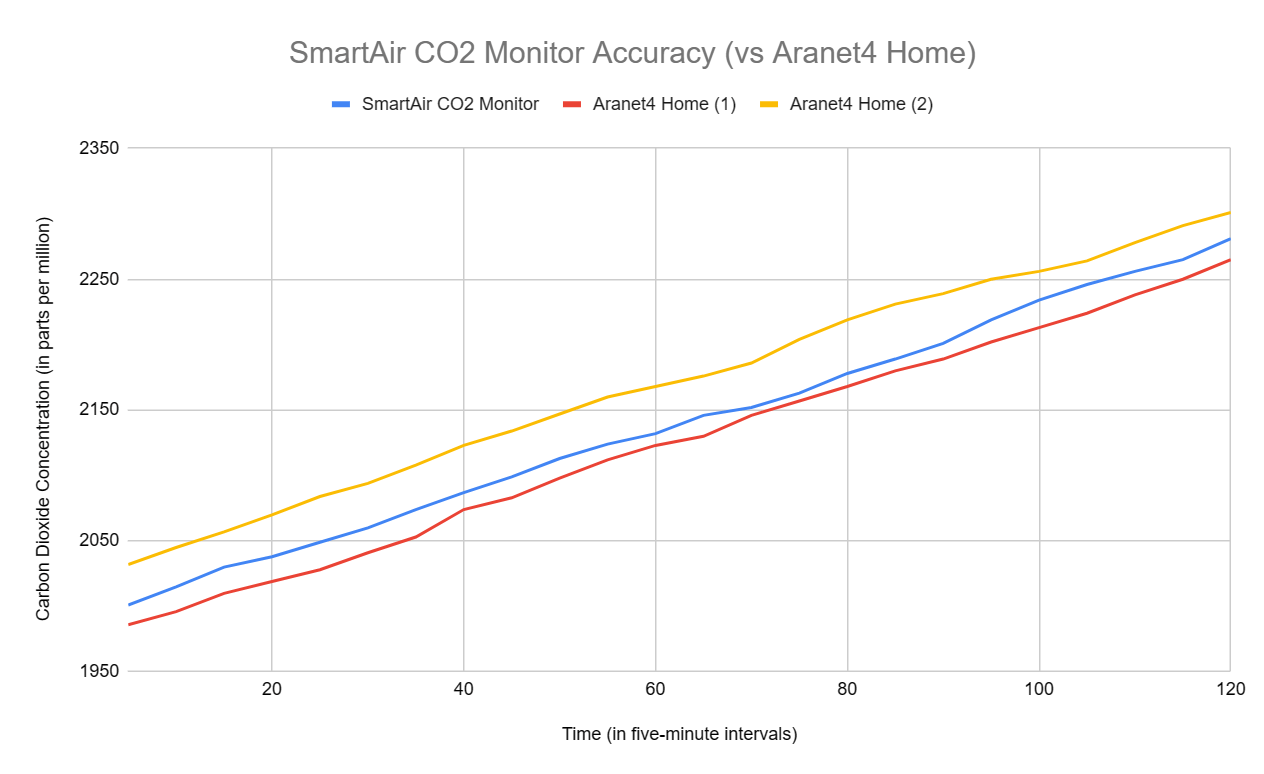
Once the three monitors reach 2000 ppm and beyond, we see that all three monitors show slightly different readings. Still, all remain within 50 ppm of each other and show the same trend of increasing carbon dioxide concentration. What is most interesting to me in this graph is the larger variation between the measurements taken by the two Aranet4 Homes than between the SmartAir Monitor and either Aranet.
While we see more variation in readings at this higher carbon dioxide concentration, all monitors still show similar readings and are well within their stated accuracies. Being a significantly less expensive monitor, I consider this a big win for the SmartAir CO2 Monitor.

In my final test, I repeated the same experiment but starting at a concentration of 3400 – 3500 ppm (depending on the monitor). At this concentration, we can see the same trend as in the previous graph – the SmartAir CO2 Monitor provided measurements between the two Aranet4 Home devices, and each showed an upward trend in carbon dioxide concentration. While the variation between devices increased to around 80 ppm at times, this is well within the stated accuracy of each monitor.
From these three tests, and just from using the monitor daily for a couple of weeks, I can conclude that it is accurate when appropriately calibrated. I often look at my SmartAir CO2 Monitor sitting next to my Aranet4 and see the same or similar readings. I’ve been very impressed with how well it performs in this regard.
While there might be some advantages to the more expensive sensor in the Aranet4, the SmartAir CO2 Monitor provides similar accuracy at a far lower price point. This is a very impressive performance and is not what I expected when I first heard about this device and its pricing!
Purchase the SmartAir CO2 Monitor | UK Store
Calibration

When not calibrated, you can quickly see differences like this in readings.
Over time, carbon dioxide sensors begin to drift, and if left unchecked, they will provide inaccurate readings over the weeks, months and years we use them. To counter this sensor drift, carbon dioxide monitors feature calibration methods – either automatic or manual. In the case of the SmartAir CO2 Monitor, there is automatic calibration, which can be disabled and manual calibration.
I’ve spoken on automatic calibration and its problems before in my Vitalight Mini CO2 Detector Review. Essentially, for every set period, the device will identify the lowest carbon dioxide value it has been exposed to and set that as the new baseline (usually either 400 ppm or 420 ppm). If the device is never exposed to ambient air, this can become a problem because the monitor might set a higher value, such as 600ppm, as the new baseline. This means that all measurements will now be 200 ppm too low.
On the SmartAir CO2 Monitor, the device will auto-calibrate every month if this option is enabled. This means that the device will take the lowest recorded value every month and set that as its baseline for the next month. If the device is used outdoors regularly or in a room that is regularly vacated long enough for CO2 levels to drop to ambient, this shouldn’t be an issue. However, if this isn’t the case, you must ensure you take the device outside at least monthly.
Now, I don’t mind having a one-month autocalibration cycle nearly as much as I mind the one-week cycle on the Vitalight Mini CO2 Detector. However, it’s essential to keep the auto-calibration in mind because it can quickly skew your readings if you aren’t aware of how to manage it.
On the other hand, the SmartAir CO2 Monitor also features on-demand manual calibrations, which can be started through the app. The process will take five minutes; during this time, you should leave the device in the air as close to 420 ppm as possible. Having the ability for manual calibration is something I consider essential in all carbon dioxide monitors, so I am glad to see it here.
Interestingly, the SmartAir CO2 Monitor also allows you to set manual offsets. If you have a professional CO2 monitor, you can align the readings on the SmartAir Monitor with that by setting an offset.
Purchase the SmartAir CO2 Monitor | UK Store
Design & Size

If you’ve used an INKBIRD IAM-T1 or Aranet4 Home before, you will already have a good idea of the size, weight, and feel of the SmartAir CO2 Monitor. While there are some differences between these three monitors, they all have a similar foundation from which they are built.
The SmartAir CO2 Monitor is a relatively small device that comes in between the INKBIRD IAM-T1 and Aranet4 in size and weight. Where I would call the Aranet4 easily pocketable, and the INKBIRD monitor not so much pocketable but more ‘baggable’, the SmartAir CO2 Monitor can fit in larger pockets. Still, it isn’t quite as compact or lightweight as the Aranet4 Home.

In the table below, you can find the dimensions and weight for each of these three monitors. I’ve chosen to compare these three as, in my mind, they are all direct competitors. They are all portable carbon dioxide monitors, and it’s obvious they’ve taken some inspiration from one another.
| Monitor | Dimensions (in mm) | Weight (in grams) |
|---|---|---|
| SmartAir CO2 Monitor | 77x77x28 | 129g |
| Aranet4 Home | 70x70x24 | 104g |
| INKBIRD IAM-T1 | 75x80x30 | 138g |
Each monitor continues to be similar when we turn the devices around. We can find vents on the sides of each device that allow air to enter the device. While these vents mean that none of the devices are waterproof or even water resistant, they are essential for allowing ambient air to enter the device to be monitored.
On the back of each device is a hook mount, which will allow the devices to be mounted on a wall if you would prefer that over having them portable or sat on a desk or table. I appreciate the inclusion of this mounting hardware, as it makes any of these monitors perfect for office or classroom use.

While there are a lot of similarities between these devices, we begin to see an end to the similarities when looking at the top of the device. The Aranet4 Home and IAM-T1 have no buttons or ways to interact with the devices (at least without removing the back covers), but the SmartAir Monitor has a single button on the top of the device. This button will be used when you need to enable Bluetooth on the device for calibration, uploading of data, or otherwise.
We also see some differences with the SmartAir CO2 Monitor on the bottom of the device. Unlike the other carbon dioxide monitors, the SmartAir product uses an internal battery, which requires a charging port. Thankfully, this port is USB Type-C, meaning nearly everyone will have the needed cable and adapter to charge their product.
The port on the bottom of the monitor means it can be permanently plugged in when mounted on a wall, but it isn’t ideal for desk-based usage. It’s impossible to stand up the device on a desk or table when charging, so it’s clear it is meant to be mounted to a wall.
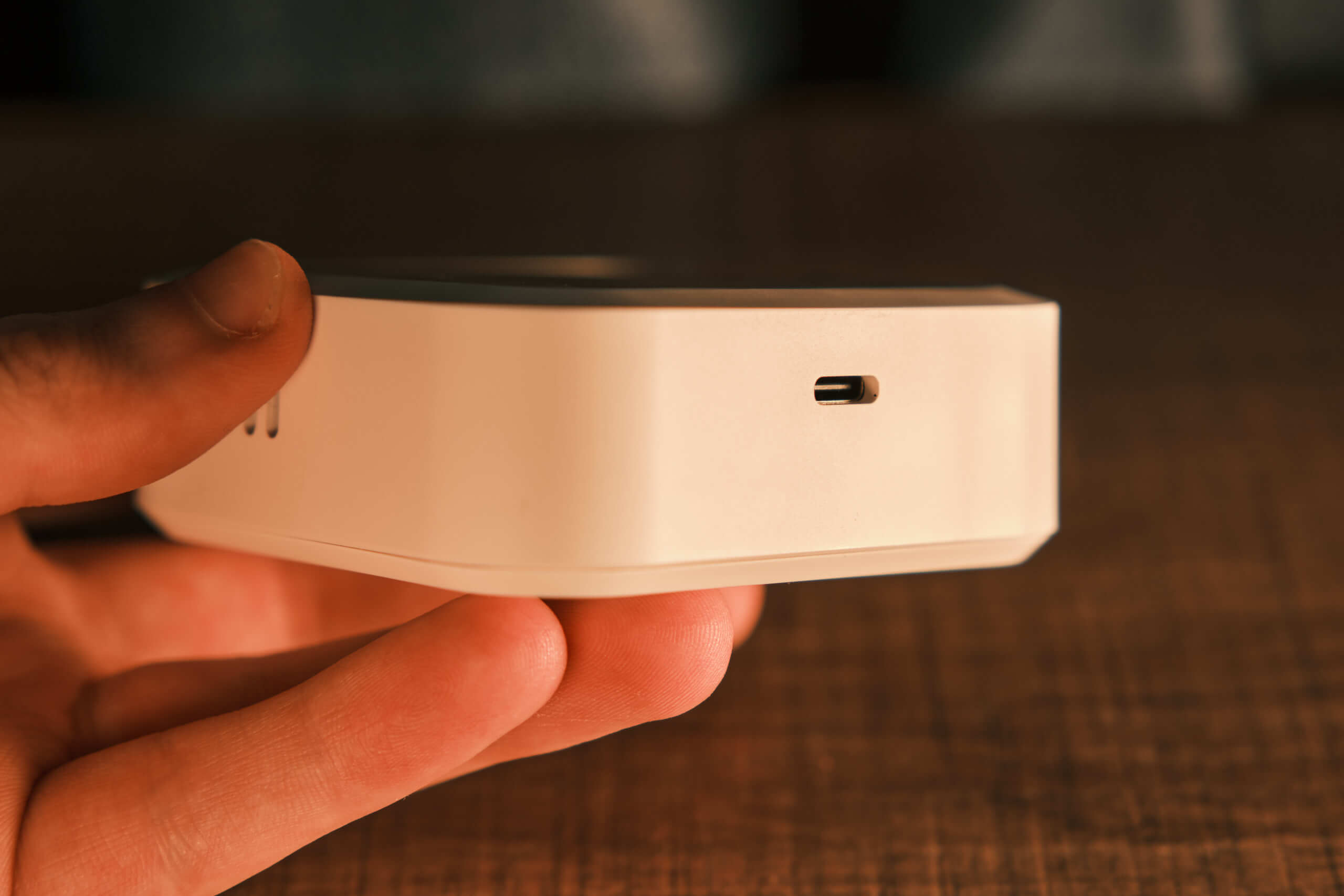
Now that we’ve discussed the rest of the device, we can move on to the most important aspect of the SmartAir CO2 Monitor’s design – the screen. When comparing the devices side-by-side, the most significant difference is the massive screen on the SmartAir device. Where both the Aranet4 Home and INKBIRD IAM-T1 have relatively small screens, the SmartAir Monitor has a much larger screen.
The screen shows your current CO2 concentration in parts per million (ppm) in large text. To the right of this are three colours, which an arrow will point to to indicate the current air quality. Thankfully, the thresholds for each colour can be adjusted in the app, meaning you can set each colour to your desired levels.
At the bottom of the device, you can find the relative humidity and temperature measurements. At the top of the screen, you can find a few indicators for WiFi and Bluetooth, the time, and a battery indicator. While it’s a small addition, I appreciate seeing the time on the device, as this isn’t usually available on carbon dioxide monitors.

While I appreciate the large screen on the SmartAir CO2 Monitor, I’ve found the E-ink screens on other carbon dioxide monitors to be better for readability and visibility in bright environments. I’ve had trouble reading the LCD screen on the SmartAir CO2 Monitor many times, and in these situations, the E-ink screens on other monitors are far superior.
However, I know that E-ink screens add a significant cost and lead time to products, so I can understand the decision to opt for an LCD screen instead. While it’s not as good as an E-ink screen, the SmartAir monitor may be only able to be priced so aggressively due to the cheaper LCD screen. Therefore, while I would prefer an E-ink screen, I can’t complain about the screen on the SmartAir CO2 Monitor. Sure, it’s harder to read in bright environments, but the monitor costs far less than the other two.
Another factor I noticed is that while the screen on the SmartAir Monitor is much larger, it doesn’t show any additional information that the Aranet4 and IAM-T1 don’t show. This isn’t an issue, but I would love to see the extra screen real estate used. For example, a rebreathed air percentage could be shown to the left of the CO2 reading (similar to what the CO2.Click Model C displays). Perhaps this is an update that could happen.
Overall, the SmartAir CO2 Monitor is well-designed and comparable to other popular carbon dioxide monitors. While the screen is much larger, it’s less visible, and I would prefer E-ink. However, at the same time, I like the inclusion of a rechargeable battery and Type-C port on the SmartAir Monitor as it will save me a significant amount of money over the years I use the device.
Size-wise, the SmartAir CO2 Monitor is slightly larger and heavier than the Aranet4 Home. While this makes it marginally harder to slip into a pocket or handbag, I consider the size and weight differences negligible in most cases. On the other hand, the IAM-T1 feels significantly less pocketable even though it’s only slightly larger.
If you’re considering using this device indoors, it’s worth remembering that unless you don’t mind regularly charging it, it’s best suited to be mounted on a wall instead of sitting on a desk or table. While I understand the decision to put the USB port at the bottom of the device, it means it can’t be stood up when charging.
Purchase the SmartAir CO2 Monitor | UK Store
Connectivity

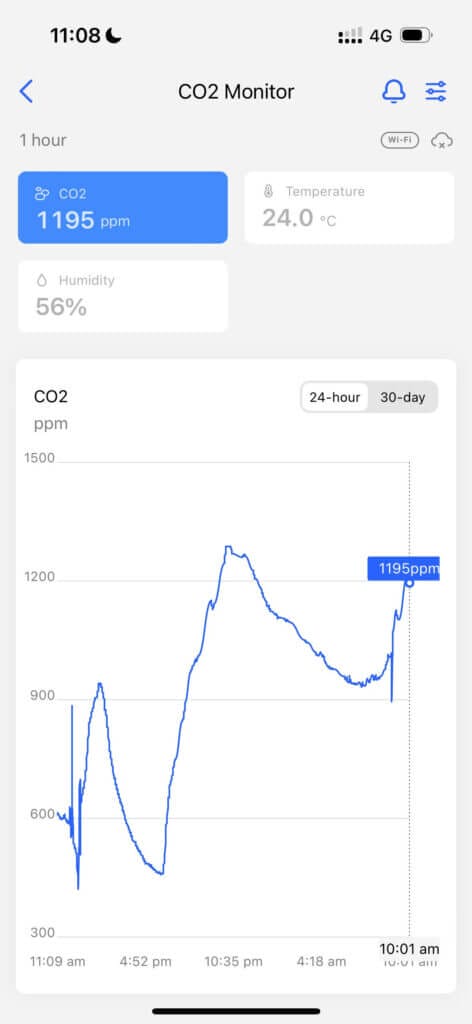
Regarding connectivity, the SmartAir CO2 Monitor does well, but it has an interesting caveat. While the device has Bluetooth and an accompanying phone app, similar to many other carbon dioxide monitors, it also supports WiFi and SmartAir’s web dashboard. This dashboard isn’t intended for general consumers but for schools, offices, and other businesses interested in monitoring multiple locations simultaneously.
This web dashboard does come at an extra cost and can only be accessed with a subscription. However, this is still a cheaper alternative than other devices. For example, in Aranet’s ecosystem, you would need Aranet4 PROs (not Aranet4 Homes) with an Aranet Base Station for this functionality. The PRO model costs more than the Aranet4 Home, and the Base Station costs many hundreds of dollars on top of that.

Image from SmartAir’s online dashboard. This service requires a subscription and is meant for users who want to manage and monitor multiple monitors (all Qingping monitors) in one place.
Even the CO2.Click Model C, which has a fantastic online dashboard and WiFi connectivity, costs much more than the SmartAir CO2 Monitor. Therefore, while most users won’t need to use the web dashboard, it’s a great low-cost option for anyone who needs to monitor multiple rooms simultaneously.
More pertinent to the general user is the smartphone connectivity and app, as these are what most users will be interacting with daily. Since Qingping manufactures the SmartAir CO2 Monitor, you must download the Qingping IoT app. If you already have an air quality monitor from Qingping, such as the Qingping Air Monitor or Air Monitor Lite, these can be monitored in the same app!
Connecting the monitor to the app is very straightforward. Download the app, select the device you want to add (CO2 & Temp & RH Monitor) and press the button on top of the device for two seconds. Once you’ve done this, the app will automatically pick up your monitor, and you’re ready to go! It’s that simple (or, at least, it was in my experience).
Once you’ve added your monitor, you can get an overview of the data from the app’s home screen. If you have multiple monitors from Qingping or SmartAir, you can see the data from each displayed here. However, since I currently only have the SmartAir CO2 Monitor, only this device shows up.
You can access historical data for carbon dioxide, temperature, and relative humidity readings by tapping on the monitor. I haven’t yet encountered a limit for the length of data held, but you can export data up to one year old, so I believe the app retains one year of data. Furthermore, the monitor will keep data locally on the device even if it isn’t connected to WiFi for an extended period. The device can store 2880 sets of data locally, meaning you only need to worry about losing data if it runs out of battery or isn’t connected to WiFi for a long time.
Interacting with the graphs on the app is a pleasant experience, and I’ve never had any issues with the app being slow or performing poorly. However, I wish I could pinch to zoom in and out on the graphs to select specific times more efficiently or quickly see when concentrations spiked. This is a minor issue, though, and didn’t hinder my daily usage much.
At the top right of the graph, you will find a slider button which will take you to the device’s settings. Since the product itself only has one button, this is where you will be changing all settings associated with the monitor. There is very little you can adjust without the app, so I recommend downloading it.

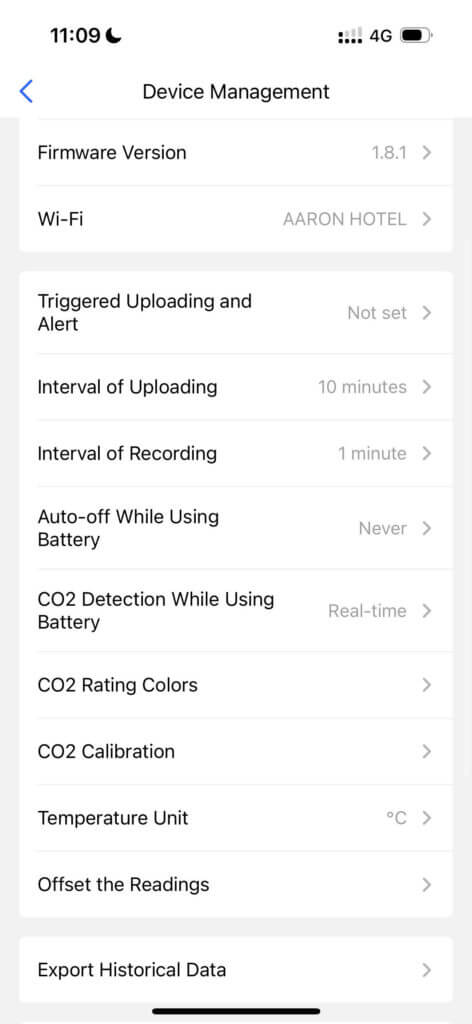
Within the settings, you have some basic settings regarding the naming and grouping of the device within the app. Below these entries, you can find options to update the device and change the WiFi network it is connected to. I appreciate the opportunity to update the device, but I’m not sure how active Qingping will be in providing updates if needed. While I can’t speak about whether the device will receive updates, the capability exists.
Under these settings, we find a more exciting set of options. The monitor is very customisable, and you can choose to balance battery life with regular updates by changing the interval or uploading and interval of recording. This can also be separately changed for when the device is relying on battery power as opposed to being plugged in.
The SmartAir CO2 Monitor also allows users to customise the CO2 rating colours displayed on the front of the device. While I don’t mind the thresholds of 1000 ppm and 1400 ppm, it’s nice to have the option to adjust these levels if you wish. If you want, you can even set alerts which will be sent to your phone when certain thresholds are reached.


Perhaps most importantly, it’s also from this settings menu that you calibrate the device when needed. This is a painless process; you will need to select the setting on your phone and press the button on top of the device for two seconds. This will begin a five-minute countdown on the monitor, after which a new baseline will be set.
Finally, the app has an option to offset readings for carbon dioxide, temperature, and relative humidity. While I haven’t needed to use this setting, it’s nice to see it included. This means if you have a monitor that you know is accurate, and the SmartAir CO2 Monitor doesn’t align, you can manually offset any of these readings to make sure they match the other device.
Now, at this point, I want to mention the caveat I alluded to. While the SmartAir CO2 monitor has Bluetooth and WiFi, these both have very different functions. Here is what each is used for:
- Bluetooth – used during the initial setup process and when you need to recalibrate the device or change settings. This is NOT on by default, and you will need to press the button on the monitor for two seconds to turn on Bluetooth and get the device to communicate with your phone.
- WiFi – used for uploading ALL data – both for your phone and the web dashboard.
This means that you cannot view data on the app when you’re out and about (and not connected to WiFi). Why? Because the SmartAir CO2 Monitor only sends data via WiFi and not Bluetooth. Instead, Bluetooth is only used to communicate between your phone and monitor when you need to change settings.
In practice, the app is useless when you are out and about, and you must rely on the monitor. When you get home, and the device connects to WiFi again, the data will be sent to your phone, and you can analyse it there. However, anytime the device isn’t connected to WiFi, you won’t be able to view data on the app.
This is an interesting design choice. I feel that it’s either to improve battery life or because the device is intended to be a static, wall-mounted monitor first and a portable monitor second. Either way, it is a significant limitation for the device, and it means that you can’t leave the device in your pocket or handbag and rely solely on the app while out and about. I don’t think this is a deal-breaker, but it is a limitation you will need to work with.
Overall, the Qingping IoT app, used with the SmartAir CO2 Monitor, is very capable, and I’ve enjoyed using it. The app is fast, fluid, and hasn’t crashed on me. It’s also very powerful, allowing users to export up to a year of data and set manual offsets for the device. While the lack of a constant Bluetooth connection means you can’t use the app while on the go, this is a limitation you can manage.
Purchase the SmartAir CO2 Monitor | UK Store
Pricing & Competition

Now that we’ve looked at every aspect of the SmartAir CO2 Monitor, it is time to discuss the pricing and competition. After all, this isn’t the only monitor available on the market! With a price of $70 (on the U.S. website), the SmartAir CO2 Monitor is instantly compelling – it offers much of the functionality of the Aranet4 Home but at a vastly lower price. Let’s see how it compares:
| CO2 Monitor | Retail Price (Not including sales) |
|---|---|
| Aranet4 Home | $249 |
| INKBIRD IAM-T1 | $169 |
| SmartAir CO2 Monitor | $69 |
| Qingping AQM Lite* | $99 |
| Vitalight Mini CO2 Monitor | $40 |
While the Aranet4 Home is often cheaper (it can often be found around $170), the SmartAir CO2 Monitor is still a much cheaper alternative. In fact, with the features that the SmartAir CO2 Monitor has, nothing compares to it for such an affordable price. The Vitalight Mini CO2 Detector is cheaper, but it also has none of the features of this monitor.
The Aranet4 Home and INKBIRD IAM-T1 have advantages – for example, they use Bluetooth to transfer data, meaning they are always connected to your phone. They also both have significantly better battery life. However, the SmartAir CO2 Monitor also has its own benefits – for one, using a rechargeable battery means you never need to worry about purchasing more AA batteries. It also has a web dashboard if you don’t mind paying the subscription fee, which neither the Aranet nor INKBIRD products have.
As always, which device is best will come down to personal preference and needs. However, the fact is that the SmartAir CO2 Monitor can compete with these far more pricey monitors and that alone is impressive. It provides a much better budget option than the Vitalight Mini CO2 Monitor, and it’s a device that makes CO2 monitoring that much more accessible.
Purchase the SmartAir CO2 Monitor | UK Store
Conclusion
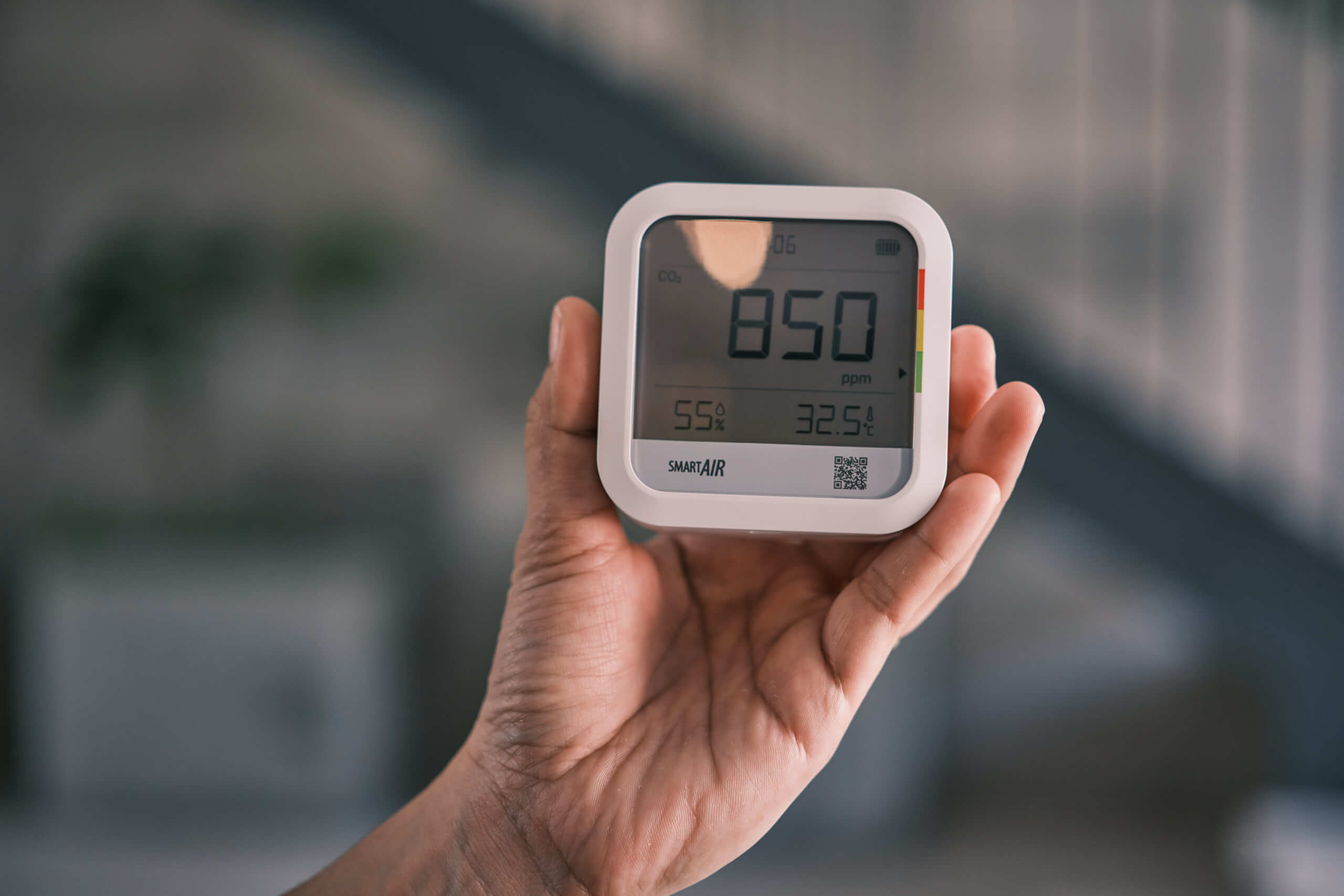
That brings us to the final section of this article. Is the SmartAir CO2 Monitor worth it? Well, here are my general recommendations:
- Looking for an affordable carbon dioxide monitor? If this is you, I would not hesitate to recommend the SmartAir CO2 Monitor. While it’s a bit more expensive than the Vitalight Mini CO2 Detector, I would recommend saving a bit more and opting for this instead.
- Are you stuck between the Aranet4 Home, IAM-T1, and SmartAir CO2 Monitor? If you’re in this group, I recommend considering if you need constant Bluetooth connectivity and longer battery life (albeit with AA batteries). Also, how important is the $100 savings for you? If it’s important, get the SmartAir Monitor.
- Do you want the best CO2 Monitor on the market? If this is you, I would still recommend the Aranet4 Home. It’s a pricey monitor, but it has a few extra features, and the excellent support of the Aranet team has shown they are willing to keep improving their product via updates.
This is all to say that the SmartAir CO2 Monitor is a great, affordable option if you need a carbon dioxide monitor. For significantly less than $100, you get a high-quality carbon dioxide monitor with all the basics covered. This is an easy monitor to recommend simply because the pricing is great.
Even if you have more money to spend, I recommend considering this monitor alongside the more expensive products. They all have different strengths, and the fact that this $70 monitor can compete at all is a very impressive feat. With that said, the SmartAir Monitor isn’t perfect, and if a second generation is released, I would like to see communication via Bluetooth and an E-ink screen (if it’s feasible at this price).
Do you have any further questions? Or, have you tried the SmartAir CO2 Monitor and have some thoughts to share? If so, please let me know in the comments below! I would love to hear from you.
Purchase the SmartAir CO2 Monitor | UK Store
SmartAir CO2 Monitor FAQ
What Is the SmartAir CO2 Monitor?
The SmartAir CO2 Monitor is a portable monitor that tracks carbon dioxide concentration, temperature, and relative humidity.
Where Can I Buy the SmartAir CO2 Monitor?
What Alternatives to the SmartAir CO2 Monitor Are There?
At this price point, there is no direct competition to the SmartAir CO2 Monitor. However, the Aranet4 Home and INKBIRD IAM-T1 are the most direct competitors.
How Does the SmartAir CO2 Monitor Compare to the Aranet4 Home?
The Aranet4 is slightly more well-rounded, with constant connectivity and on-demand readings. However, it also costs $100 more, and the SmartAir Monitor has the advantages of a rechargeable battery and support for an online dashboard.
Is the SmartAir CO2 Monitor Accurate?
Yes, I found it accurate.
What Does the SmartAir CO2 Monitor Measure?
The SmartAir CO2 Monitor measures CO2 concentration, temperature, and relative humidity.
Have Questions or Comments?
Join the discussion on the BreatheSafeAir Community Forum. Ask any questions you have about air quality or adjacent topics and get quick answers!
SmartAir CO2 Monitor

The SmartAir CO2 Monitor is a carbon dioxide monitor from SmartAir. It is inexpensive, accurate, and features both Bluetooth and WiFi connectivity.
Product Brand: SmartAir
4.5
Pros
- Inexpensive, especially considering the features
- Accurate (NDIR sensor from Sensirion)
- Bluetooth and WiFi
- Rechargeable battery
- 6–30-day battery life
- Online dashboard support
- Uses Qingping IoT app which supports other QP products
- Large screen ideal for wall-mounting
Cons
- LCD screen isn't great in bright environments
- No data-sharing over Bluetooth


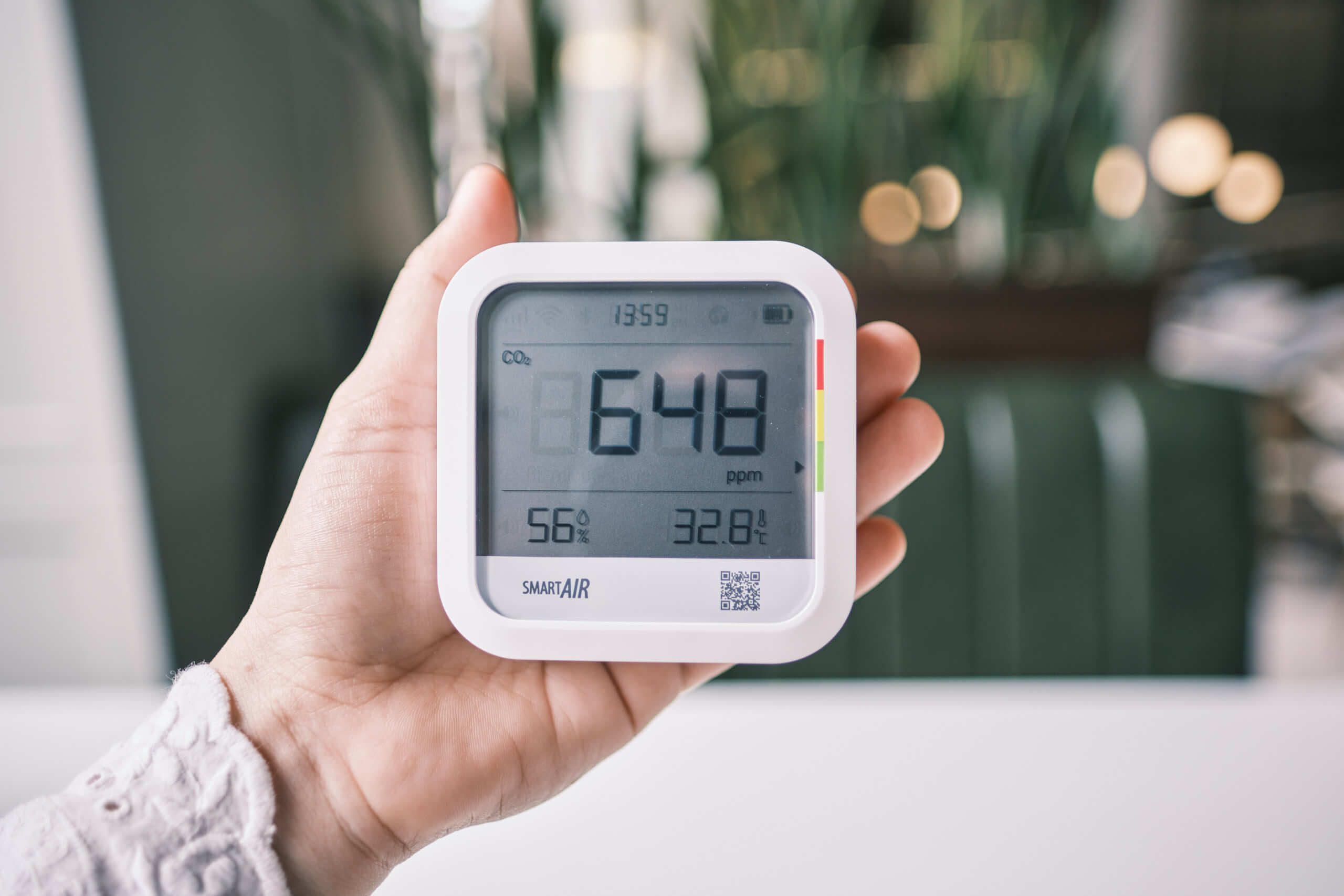
Great review, Ethan!
Was looking on this Qingping CO2 Meter (original unbranded version) and this review helped a lot.
Just placed an order on Aliexpress for under 40$.
Do you plan to make a video review too?
Awesome, I’m glad to hear the review was helpful! I hope you like the device.
Btw, is the device accesible via app remotely (let’s say via cellular data), if the device is at home/office and connected to WiFi?
If so, that could be an advantage over Bluetooth only Aranet4 / Inkbird IAM-T1
You mention that automatic calibration can”t be disabled, but SmartAir website states:
“If you need a more accurate reading, the auto-calibrate can be switched off and you can rely on regular manual resets but for most people, we recommend keeping the auto-calibrate switched on.”
Who’s wrong? 🙂
Thank you for bringing this to my attention. I am wrong and I have updated the article to reflect that.
How easy is the SmartAir CO2 to read in complete darkness? This is both a limitation and a feature of the Aranet4.
Hi Larry,
Unfortunately, it suffers the same issue as the Aranet4. Both are very hard to see in darkness, but the SmartAir device is also hard to see in direct sunlight whereas the Aranet4 always has fantastic screen contrast due to the e-ink display.